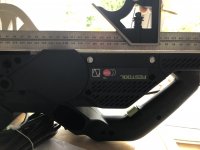Hello All
I've just received a brand new HL 850 planer from Festool. I'm not expecting the precision of a hand plane but I'm surprised how much of a difference in height there is between the front and back plates. Running my Starrett square's ruler from front to back shows a very noticeable gap (no need for a feeler gauge).
Does this seem correct? I've spoken to Festool and they aren't able to tell me over the phone if this is as it should be, or not.
Please see the attached photo for reference.
[attachimg=1]
I've just received a brand new HL 850 planer from Festool. I'm not expecting the precision of a hand plane but I'm surprised how much of a difference in height there is between the front and back plates. Running my Starrett square's ruler from front to back shows a very noticeable gap (no need for a feeler gauge).
Does this seem correct? I've spoken to Festool and they aren't able to tell me over the phone if this is as it should be, or not.
Please see the attached photo for reference.
[attachimg=1]

